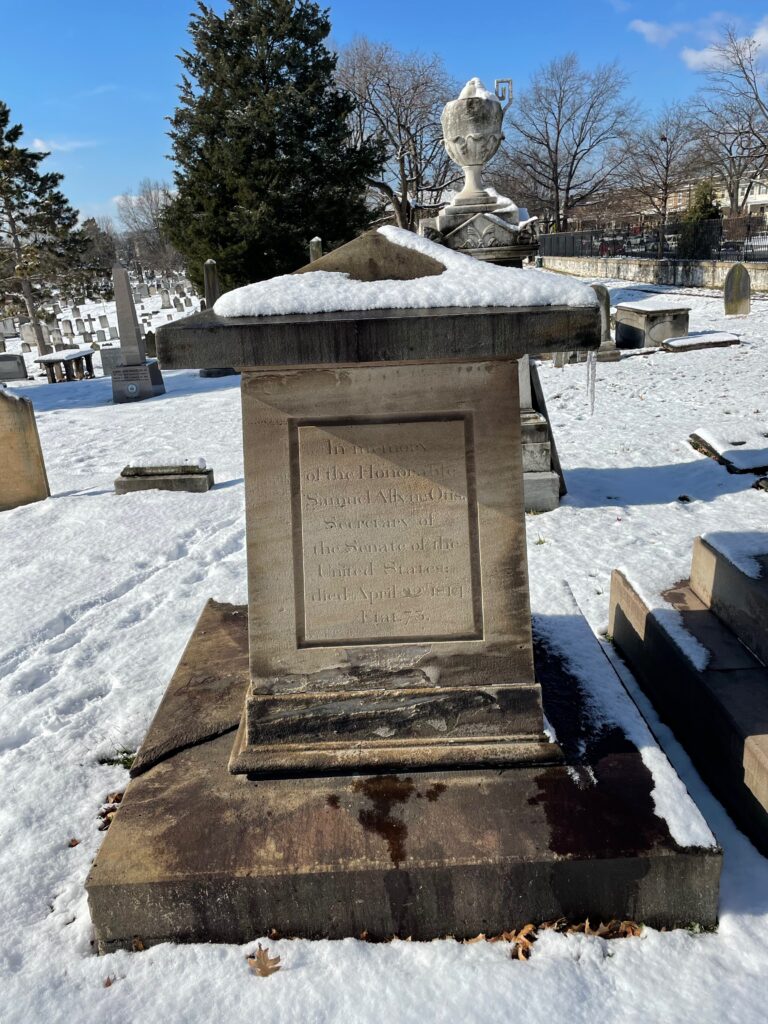Erik Visits an American Grave, Part 1,290
This is the grave of Samuel Otis.

Born in 1740 in Barnstable, Massachusetts, Otis grew up fairly well off, went to Harvard, and graduated in 1759, which was an age still common at that time. He went into business and had a successful mercantile firm in Boston. He was a vigorous support of the revolutionary movement and given his wealthy, was, like John Hancock, a really important person in terms of funding, supplies, and respectability. He strongly supported the Revolution when it began in 1775, was elected to the Massachusetts legislature in 1776, and in 1777 was named the person in charge of supplying clothing to the Continental Army. Given the complete uselessness of Congress in these years, having someone like Otis to do basic things like find clothing was really necessary. It is hard for me to think of a more appropriate founding principle for this nation than to start a war out of tax revolt, then refuse to raise the taxes to fund the war. It was really a miracle that the U.S. won this thing and even that was probably in the end as much about yellow fever decimating British troops in the South as anything else.
Anyway, Otis mostly remained an important Massachusetts rather than national figure over the next decade. He helped design the Massachusetts state constitution. He served some more terms in the state legislature. He was Speaker of the House for the state in 1784.
In 1787, Otis was elected to the Continental Congress, just at the moment when the Constitution was about to replace the body with the new Congress. Otis was supportive of the Constitution, as was most of the northern merchant class. He wasn’t destined to a traditional role in the new nation though. He loved politics and wanted to remain involved, but electoral politics would not be his future.
Rather, Otis was elected Secretary of the U.S. Senate. This was a position of unknown importance in the new government, though to be fair, so was every post. Certainly the Founders did not initially design the Supreme Court to be as powerful as it soon became, for example. Initially, the post was likely to go to Charles Thomson, who was secretary of the Continental Congress. But he alienated people by openly lobbying for a position in Washington’s Cabinet, which was a big no-no in late 18th century politics, a time when the most openly ambitious men had to deny their ambition openly while working behind the scenes and through proxies. So Thomson’s enemies cooked up a scheme for him to travel to Mount Vernon to meet with Washington and then elected Otis, who was John Adams‘ idea.
But what was this job to do? First, he held the Bible for Washington’s inauguration. But he was a pretty shrewd operator and went out of his way to seek power for the position. He set the legislative rules of the Senate and he also became the key go-between before the Senate and the House. All of this made people realize this could be a real position and others tried to maneuver their way into it. But Otis was not going anywhere. Thanks to Adams, he was secure until 1801. But then it seemed Jefferson might move him and hand the plumb patronage position to one of his supporters. Otis held on by handing over the power of printing Senate business to William Duane, the influential Jeffersonian editor. He could have gone back to Massachusetts and worked there in some elite position, but he really didn’t want to leave Washington, now that the city was semi-sorta-completed.
Moreover, as he aged, Otis got slower and kind of lazy. Senators reported that the reports were not getting done on time and that his record keeping had turned disastrous. This is probably true but by the 1810s, he had become such an institution that it was impossible to get rid of him. He was the Senate’s memory as well, which was important because in these days, there was massive turnover in the institution. I’d guess that at least half of the senators I have profiled over the years in this series left office early. No one really even expected you to serve out a term. It wasn’t a big deal if you didn’t. So that institutional memory mattered. Meanwhile, he still managed to keep up his business interests, passing many of them down to his son Harrison Gray Otis, one of the most important Federalists of the Early Republic.
Otis died, still in office, in 1814, after 25 years. He was 73 years old.
Samuel Otis is buried in Congressional Cemetery, Washington, D.C.
If you would like this series to visit other secretaries of the Senate, you can donate to cover the required expenses here. Walter Lowrie is in Manhattan and John Weiss Forney is in Bala Cynwyd, Pennsylvania. Previous posts in this series are archived here.


